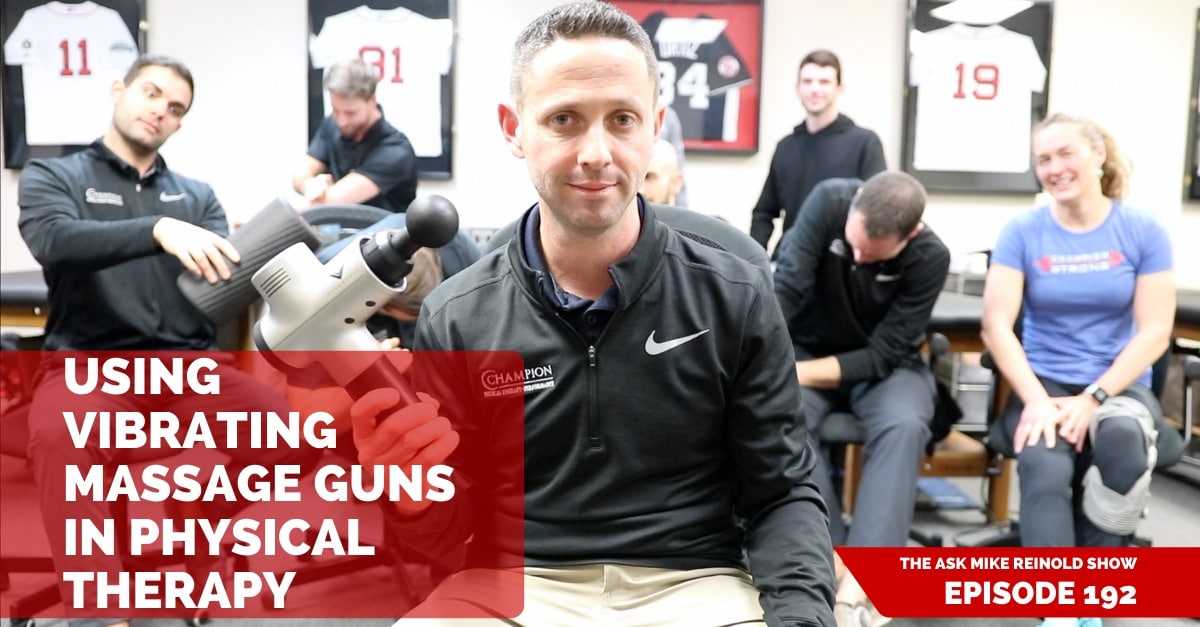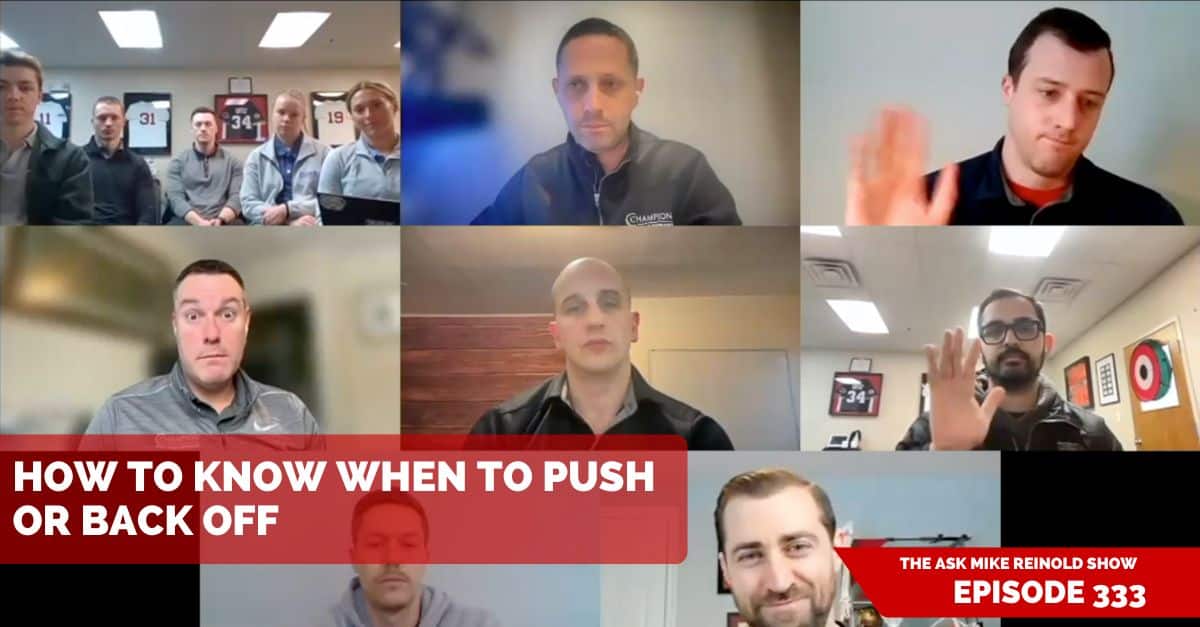On this episode of the #AskMikeReinold show we talk about the popular vibrating massage guns, if we use them at Champion, and if we consider this a form of “skilled” therapy that a physical therapist should be performing. To view more episodes, subscribe, and ask your questions, go to mikereinold.com/askmikereinold.
- We have an updated episode on the topic of Percussion and Vibration Therapy
#AskMikeReinold Episode 192: Using Vibrating Massage Guns in Physical Therapy
Listen and Subscribe to Podcast
You can use the player below to listen to the podcast or subscribe. If you are enjoying the podcast, PLEASE click here to leave us a review in iTunes, it will really mean a lot to us. THANKS!
Show Notes
Transcript
Mike Reinold: On this episode of the Ask Mike Reinold show, we talk about using vibrating massage guns in physical therapy.
(Intro)
Student: All right, Daniel from Birmingham asks, “What is your opinion of using vibrating massage guns in PT practice? You consider this skilled therapy in order to bill for it?”
Mike Reinold: I love how people jam three questions into one sentence, right? That’s kind of cool. What was his name again?
Student: Daniel.
Mike Reinold: Daniel from the ‘ham. Good question. So vibrating massage guns. So again dissecting the question. Do we like vibrating massage guns? Right? Is it skilled? And how do you bill for it? Which isn’t our world, but that’s pretty interesting.
Mike Reinold: So why don’t we start with this. Dewey, who here uses vibrating massage guns?
Dan Pope: Like in practice?
Mike Reinold: Yeah, that’s a good one. Who likes them? Do we have them here at Champion?
Dave Tilley: Yes, yes.
Lenny Macrina: Yes.
Mike Reinold: We have a lot. Do our clients like them?
Lenny Macrina: Love them.
Mike Reinold: Love them. Something to keep in mind. Well, okay, we’ll talk about that. The clients love that. That’s interesting. So it must make them feel better.
Lenny Macrina: Right, right.
Mike Reinold: Good. Do we use them in physical therapy here?
Dan Pope: Sometimes I think.
Mike Scaduto: I rarely administer the treatment myself.
Mike Reinold: I feel like I’ve tried it a couple of times and just felt bad about it the whole time. I feel like, well, you know what, it’s, it comes down to a big question that always happens in physical therapy. We have limited time with our people. Even if you’re in a one on one setting with a person like we are here, even if you’re in that setting here, we have limited time with our people and you have to pick and choose what we decide to do with them.
Mike Reinold: Now that being said, I am one of those people that like to think about the end game and what is our outcome that we’re trying to achieve and then we’ll figure out any way to get there in my mind. So I think what I’m saying here is I don’t necessarily think it’s a bad idea, but I think none of us are currently using it. And maybe we kind of talk about that as to why, right? Because we’re big vibrating massage gun fans. We have them, we use them here, but I don’t think we use them in physical therapy. Who wants to start and kind of talk about that? I kind of led into that a little bit, but I don’t know, Dan, you said you’ve tried it sometimes. Why don’t you comment on why you decided to use it on that person and why aren’t you using it more?
Dan Pope: Yeah. I guess this kind of ties into Dan’s original question. Whether or not it’s skilled physical therapy. I think it’s a tool just like anything else. So if you have someone that you feel like the muscle is related to their pain and/or you’re trying to gain length in that muscle, something along those lines and you think that the gun is going to be the best possible tool that you have at your disposal, then yeah, use your brain, figure out the area that is limited. You want to try to address this and the tool that you have is the best for that. That being said, Mike and I came to this conclusion that we don’t have all the time in the world to work with our patients. So is it always the best tool that we have at our disposal?
Dan Pope: I would say a lot of times it’s not. A lot of times I’m using my hands and maybe I’m using some needles. Oftentimes I’m outside teaching people exercise technique, going through exercise programs. So it’s not always going to be the best thing that I do use. But I do think it’s probably going to be beneficial in some areas and some people, especially people that like it, have that buy in for it.
Mike Reinold: Right. I think that’s well said. And then I think the other thing too is the skilled therapy and do we use it, is if it’s something that they can do to themselves equally as well? It’s almost like then an exercise for me, it’s more prescribed as an exercise. All right, go do your vibrating gun, like me. And why am I doing that for you?
Mike Reinold: I think that’s another thing that kind of comes up a little bit sometimes. Why would we use it? What’s a scenario that would be appropriate to use it as a skilled therapy?
Mike Scaduto: I think the skill is deciding who would benefit from it more than someone else and when to use it and where to use it.
Mike Reinold: Perfect.
Mike Scaduto: And how long? And that’s the skill involved, not the actual administering of the modality.
Mike Reinold: Perfect. I could not have said that any better, Mike. The skill is you decided that for what was happening, this was the best tool for you to use. So I think we’ve now officially answered the question: is it skilled therapy? I think we could argue it technically is because it’s not the tool. It is your decision to apply it that was skilled.
Mike Reinold: So we got that. That’s an interesting kind of point right there. I think if there’s other things that we can do that’s on the table too. Anybody disagree or anybody think differently? But I think Mike nailed the skill. The skill is our decision making process, right?
Dave Tilley: Yeah, I would agree. I think, again, you guys mentioned it, but we’re trying to maximize the time they need us for. The critical thinking skills, the creation of a program, the teaching of specific exercise, selection technique. And I don’t think it’s bad to have that on your list of things to maybe do, if manual therapy is appropriate. But I feel like there’s so many other things that they want me to be involved in that I’m trying to take the big rocks down first before I do that.
Dave Tilley: Maybe in follow up treatment it’s more appropriate. But definitely the first few, it’s not really on top of my list.
Mike Reinold: Yeah. You whip that out on day one, you’re going to lose some people, you know what I mean? They’re going to be like, well, I can do this myself. Why am I coming for you to do this? That’s always an interest. Is there any specific thing that we think that this would be perfect for?
Dave Tilley: Recovery maybe on your own?
Mike Reinold: Yeah, well I meant as a skilled therapist, but, yeah, we’re pro-massage guns for your own recovery and stuff. But what about like tone, spasticity and tone, or something like that, which happens, right? Like doing that for 30 seconds to a minute or whatever it may take to reduce some spasm and some tones and then that way maybe your additional things could have a better impact.
Mike Reinold: I like that. Right.
Dave Tilley: It’s kind of like heat too. Sometimes heat is just like there to relax it. You can do better manual therapies.
Mike Reinold: But I don’t think we see a ton of people in spasm. Right? But I think that’s kind of our point. So maybe it’s not there, but, I think that’s one way we would do it.
Dan Pope: Yeah. And I don’t do this a ton personally cause I’m not like going crazy in terms of manual techniques. But as a manual therapist you’re probably going to be overusing your hands, your fingers, that type of thing. I think it is another tool that probably has a similar effect to some of the other things that we do. But you could probably put in your arsenal so you don’t end up injuring yourself and keep yourself safe over the course of time.
Mike Reinold: That’s a good point? Another good pro for it. I think, solid answers right now. So just to recap a little bit, we are all very pro the massage guns, right? Our clients love them, our fitness clients, our athletes. I mean they love them. They end up buying their own, oftentimes. It is impressive.
Mike Reinold: So clearly they make them feel better, they feel more mobile after, they feel like they recover a little bit better. They love doing them before they train or they do their sporting activity, whatever. So these are good devices, right? I’m not here to tell you why or the specifics of it, but I think we’re all pro using them, right? We use them here all the time. I think we agree with you that there is a question of, is this skill? But by far the biggest thing that you’re doing here is it’s your clinical reasoning that is the skill to decide if it’s appropriate for the person.
Mike Reinold: So I think you could argue it’s skillful, but I do think if you are overusing this and doing it too much, I think you’re barking up the wrong tree. Right. That a good kind of summary? The best way I think you could use this as giving the person a tool to try to maintain some of the things that maybe you’ve helped them with, with your treatments, that they can do on their own in their home exercise program. And I think that would be a great way of engaging that person and really giving them a little freedom to do some of that stuff on their own.
Mike Reinold: Right. Makes sense? Sweet. So great question. I appreciate it. Again, head to MikeReinold.com. Click on that podcast link and you can fill out the form to ask us more questions like that. Keep them coming and we’ll keep answering.
Mike Reinold: Nobody listens this far in the episode probably. So we can just really talk right now, but I’m pretty sure I delete some of the questions there. We have over a thousand questions, we’ve had over a thousand questions come in. We answer a lot, right? We’ve had almost 200 episodes now. We get a ton of questions, but we try to pick out the ones that are most applicable to everybody. So keep them coming and we’ll see you on the next episode.





